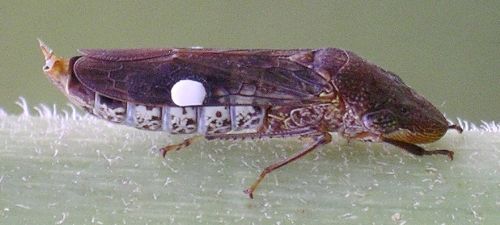by Valerie
September, 2006Glassy-winged Sharpshooter This month we turn our attention to one of the largest of our leafhoppers: the glassy-winged sharpshooter (Homalodisca vitripennis). At almost ½ inch in length, it is no monster bug, but most members of this big family are less than half that size. Leafhoppers are members of the order Homoptera which includes such diverse groups as the cicadas, aphids, and scale insects. They feed on plants, sucking juices through a tube located far back on the underside of their head. As they feed, they ingest so much liquid that it is excreted almost constantly in a series of droplets consisting of filtered plant sap known as honeydew. Sharpshooters eject the droplets with such force that it lands several inches away, which may be one source of their name. The other possible basis for the moniker "sharpshooter" could be the way they propel their bullet-shaped bodies with strong force by using their long hind legs. A combination of their initial leap and then flight is an efficient way to evade predators. The individual pictured above is a female, which is evident by the chalky white lumps on her wings. These odd features are mounds of a waxy secretion called egg brochosomes and are produced by the Malpighian tubules, which are insect excretory organs similar in function to a mammal's kidneys. Brochosomes are produced by most leafhoppers and the insects use the substance to coat their bodies, much as birds use oil to waterproof their feathers. A more specialized use of the material is as an egg cover and that's where the lumps on this sharpshooter come in. The female has cached the brochosomes on her wings and she will use the specialized spines on her back legs to rub them off and spread the stuff over a leaf once she has inserted her eggs, forming a protective coating. This species is very common in our area and easy to observe in gardens. Although they feed on the plants, glassy-winged sharpshooters are never too numerous and do little actual damage. |